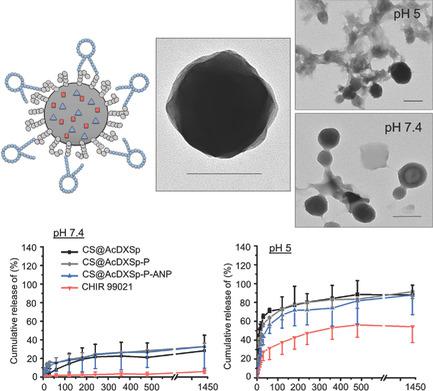当前位置:
X-MOL 学术
›
Adv. Funct. Mater.
›
论文详情
Our official English website, www.x-mol.net, welcomes your feedback! (Note: you will need to create a separate account there.)
Dual‐Drug Delivery Using Dextran‐Functionalized Nanoparticles Targeting Cardiac Fibroblasts for Cellular Reprogramming
Advanced Functional Materials ( IF 19.0 ) Pub Date : 2018-01-11 , DOI: 10.1002/adfm.201705134 Mónica P. A. Ferreira 1 , Virpi Talman 2 , Giulia Torrieri 1 , Dongfei Liu 1, 3 , Gonçalo Marques 1, 4 , Karina Moslova 5 , Zehua Liu 1 , João F. Pinto 4 , Jouni Hirvonen 1 , Heikki Ruskoaho 2 , Hélder A. Santos 1, 3
Advanced Functional Materials ( IF 19.0 ) Pub Date : 2018-01-11 , DOI: 10.1002/adfm.201705134 Mónica P. A. Ferreira 1 , Virpi Talman 2 , Giulia Torrieri 1 , Dongfei Liu 1, 3 , Gonçalo Marques 1, 4 , Karina Moslova 5 , Zehua Liu 1 , João F. Pinto 4 , Jouni Hirvonen 1 , Heikki Ruskoaho 2 , Hélder A. Santos 1, 3
Affiliation

|
The inability of the heart to recover from an ischemic insult leads to the formation of fibrotic scar tissue and heart failure. From the therapeutic strategies under investigation, cardiac regeneration holds the promise of restoring the full functionality of a damaged heart. Taking into consideration the presence of vast numbers of fibroblasts and myofibroblasts in the injured heart, direct fibroblast reprogramming into cardiomyocytes using small drug molecules is an attractive therapeutic option to replenish the lost cardiomyocytes. Here, a spermine‐acetalated dextran‐based functional nanoparticle is developed for pH‐triggered drug delivery of two poorly water soluble small molecules, CHIR99021 and SB431542, both capable of increasing the efficiency of direct reprogramming of fibroblast into cardiomyocytes. Upon functionalization with polyethylene glycol and atrial natriuretic peptide, the biocompatibility of the nanosystem is improved, and the cellular interactions with the cardiac nonmyocytes are specifically augmented. The dual delivery of the compounds is verified in vitro, and the compounds exerted concomitantly anticipate biological effects by stabilizing β‐catenin (CHIR99021) and by preventing translocation of Smad3 to the nucleus of (myo)fibroblasts (SB431542). These observations highlight the potential of this nanoparticle‐based system toward improved drug delivery and efficient direct reprogramming of fibroblasts into cardiomyocyte‐like cells, and thus, potential cardiac regeneration therapy.
中文翻译:

使用右旋糖酐功能化纳米粒子靶向心脏成纤维细胞进行双重药物递送,以进行细胞重编程
心脏无法从缺血性损伤中恢复过来,导致形成纤维化疤痕组织和心力衰竭。根据正在研究的治疗策略,心脏再生有望恢复受损心脏的全部功能。考虑到受伤心脏中存在大量成纤维细胞和肌成纤维细胞,使用小分子药物将成纤维细胞直接重编程为心肌细胞是补充丢失的心肌细胞的一种有吸引力的治疗选择。在这里,开发了一种基于精胺缩醛葡聚糖的功能性纳米颗粒,用于通过pH触发的两种水溶性差的小分子CHIR99021和SB431542的药物递送,均能够提高成纤维细胞直接重编程为心肌细胞的效率。在用聚乙二醇和心钠素功能化后,纳米系统的生物相容性得到改善,并且与心脏非肌细胞的细胞相互作用也得到了特别增强。化合物的双重递送已在体外得到验证,并且这些化合物通过稳定β-连环蛋白(CHIR99021)和防止Smad3易位到(肌)成纤维细胞核(SB431542)来同时发挥生物学作用。这些观察结果凸显了这种基于纳米颗粒的系统在改善药物输送和将成纤维细胞有效地直接重编程为心肌样细胞方面的潜力,从而潜在地进行了心脏再生治疗。与心脏非肌细胞的细胞相互作用被特别增强。化合物的双重递送已在体外进行了验证,并且这些化合物通过稳定β-连环蛋白(CHIR99021)和防止Smad3移位到(肌)成纤维细胞核(SB431542),从而发挥了预期的生物学作用。这些观察结果凸显了这种基于纳米颗粒的系统在改善药物输送和将成纤维细胞有效地直接重编程为心肌样细胞方面的潜力,从而潜在地进行了心脏再生治疗。与心脏非肌细胞的细胞相互作用被特别增强。化合物的双重递送已在体外进行了验证,并且这些化合物通过稳定β-连环蛋白(CHIR99021)和防止Smad3移位到(肌)成纤维细胞核(SB431542),从而发挥了预期的生物学作用。这些观察结果凸显了这种基于纳米颗粒的系统在改善药物输送和将成纤维细胞有效地直接重编程为心肌样细胞方面的潜力,从而潜在地进行了心脏再生治疗。
更新日期:2018-01-11
中文翻译:

使用右旋糖酐功能化纳米粒子靶向心脏成纤维细胞进行双重药物递送,以进行细胞重编程
心脏无法从缺血性损伤中恢复过来,导致形成纤维化疤痕组织和心力衰竭。根据正在研究的治疗策略,心脏再生有望恢复受损心脏的全部功能。考虑到受伤心脏中存在大量成纤维细胞和肌成纤维细胞,使用小分子药物将成纤维细胞直接重编程为心肌细胞是补充丢失的心肌细胞的一种有吸引力的治疗选择。在这里,开发了一种基于精胺缩醛葡聚糖的功能性纳米颗粒,用于通过pH触发的两种水溶性差的小分子CHIR99021和SB431542的药物递送,均能够提高成纤维细胞直接重编程为心肌细胞的效率。在用聚乙二醇和心钠素功能化后,纳米系统的生物相容性得到改善,并且与心脏非肌细胞的细胞相互作用也得到了特别增强。化合物的双重递送已在体外得到验证,并且这些化合物通过稳定β-连环蛋白(CHIR99021)和防止Smad3易位到(肌)成纤维细胞核(SB431542)来同时发挥生物学作用。这些观察结果凸显了这种基于纳米颗粒的系统在改善药物输送和将成纤维细胞有效地直接重编程为心肌样细胞方面的潜力,从而潜在地进行了心脏再生治疗。与心脏非肌细胞的细胞相互作用被特别增强。化合物的双重递送已在体外进行了验证,并且这些化合物通过稳定β-连环蛋白(CHIR99021)和防止Smad3移位到(肌)成纤维细胞核(SB431542),从而发挥了预期的生物学作用。这些观察结果凸显了这种基于纳米颗粒的系统在改善药物输送和将成纤维细胞有效地直接重编程为心肌样细胞方面的潜力,从而潜在地进行了心脏再生治疗。与心脏非肌细胞的细胞相互作用被特别增强。化合物的双重递送已在体外进行了验证,并且这些化合物通过稳定β-连环蛋白(CHIR99021)和防止Smad3移位到(肌)成纤维细胞核(SB431542),从而发挥了预期的生物学作用。这些观察结果凸显了这种基于纳米颗粒的系统在改善药物输送和将成纤维细胞有效地直接重编程为心肌样细胞方面的潜力,从而潜在地进行了心脏再生治疗。



























 京公网安备 11010802027423号
京公网安备 11010802027423号